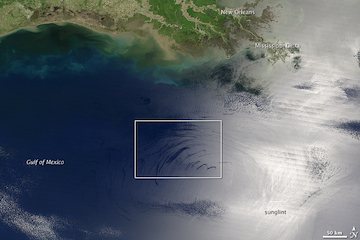410716-oil seeps2.jpg

Oil seeps in the Gulf of Mexico seen from space. Credit: NASA
For some tiny organisms that live near the surface of the oceans, a big oil spill is a disaster. But a slow seepage of oil from below can be like a free lunch.
Seeps occur along the transition zone between land and the deep ocean. There’s a thinner layer of rock above reservoirs of oil and natural gas, so the hydrocarbons bubble up through the cracks in the ocean floor and float to the surface.
A recent study found that seeps in the Gulf of Mexico, off the mouth of the Mississippi River, seem to support abundant supplies of the tiny plant-like organisms known as phytoplankton. Researchers used satellite-based radar to identify regions where hydrocarbons were making it to the surface. They then used observations from satellites and ships to measure the amount of phytoplankton both inside and outside these regions. They saw a lot more phytoplankton in the areas where the oil was making it to the surface.
Most of the phytoplankton are found a few hundred feet below the surface, where there are more nutrients. In the seep areas, though, the phytoplankton were much closer to the surface. And the amount of phytoplankton at the surface was greater as well.
The researchers suggest that as the oil and gas rise through the water, they carry nutrients from near the ocean floor. That not only brings more nutrients, but it carries them closer to the surface. And some of the hydrocarbons reach the surface, where they may stimulate the growth of phytoplankton — providing a free lunch for some tiny organisms.

